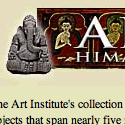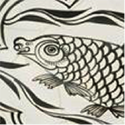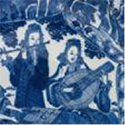|
|
| Show All 9 Results (Text Only) |
|
| Art Access: Art of India, Himalayas, and Southeast Asia |
|
|
This introduction to the art of South and Southeast Asia features 15 representative objects (mostly Hindu and Buddhist sculptures) from the Art Institute's collection. The objects have good descriptive text with links to an excellent glossary and maps. The site also includes four lesson plans (specifically for grade levels 1-3, 4-8, 7-8, and 9-12, but adaptable for all age groups). Each lesson plan includes a list of the fulfilled Illinois Learning Standards for that plan, and the lesson plan Divine Faith Discussion lists some Buddhist, Hindu, and Islamic places of worship in the Chicago area. There is also a Family Activities section (with hands-on activities for younger children) and a bibliography of books and media.
Go to Museum Resource: https://archive.artic.edu/indian/ | |
|
|
| Educator Resource Packet: Camel and Rider |
|
|
"This ceramic sculpture of a camel and rider is an example of a type of mingqi (pronounced ming-chee), or tomb figure. During the Tang Dynasty whenever a rich or powerful person died they were buried with clay objects depicting people, animals, and fantastic creatures." With discussion questions, classroom applications, and glossary.
Go to Museum Resource: https://www.artic.edu/collection/resources/educator-resources/16-educator-resou... | |
|
|
| Educator Resource Packet: Flowering Cherry with Poem Slips by Tosa Mitsukoi |
|
|
"This screen celebrates the Japanese tradition of viewing cherry blossoms to mark the arrival of spring. The tree’s blossoms and hanging poem slips create an elegant design against the gold of the silk. This teaching packet includes an essay, discussion questions, activity ideas, and a glossary."
Go to Museum Resource: https://www.artic.edu/collection/resources/educator-resources/21-educator-resou... | |
|
|
| Educator Resource Packet: Shukongojin |
|
|
"The Art Institute’s figure of Shukongojin, with his demon-like body, flaring eyes, and mouth stretched in a scream, might have originally terrified an oncoming visitor to the temple he guarded, but might have also instilled a sense of protection and reassurance for the visitor who hoped nothing would disturb his meditations once inside. For the viewer today, Shukongojin looks down from his rock-like pedestal, imposing both a sense of awe and curiosity about the target of his aggressive presence. This teaching packet includes an essay, discussion questions, activity ideas, a glossary, and an image of the artwork."
Go to Museum Resource: https://www.artic.edu/collection/resources/educator-resources/34-educator-resou... | |
|
|
| Educator Resource Packet: Southern Barbarians (Namban byobu) |
|
|
"This screen portrays a ship arriving in Japan from Portugal with European merchants in pantaloons and broad-brimmed hats bearing exotic products. The Japanese, in long, flowing patterned robes and sandals, are on the shore picnicking and curiously watching the arrival of the Portuguese. This teaching packet includes an essay, discussion questions, activity ideas, and a glossary."
Go to Museum Resource: https://www.artic.edu/collection/resources/educator-resources/35-educator-resou... | |
|
|
| Lesson Plan: Concepts of Nature [PDF] |
|
|
Lesson plan related to module on Taoism: Taoist cosmology was shaped by the way in which the Chinese traditionally understood the world. Taoists believe that when the world began, there was only the Tao, a featureless, empty void able to be filled with the potential of all things. At this point, the Tao generated swirling patterns of cloudlike energy, called qi (pronounced "chee"). This energy developed two complementary aspects: yin, which is dark, heavy, and feminine, and yang, which is light, airy, and masculine. Yin energy sank to form the earth, yang energy rose to form the heavens, and both energies harmonized to form human beings. Consequently, the human body holds within it the energies of both the earth and the heavens. Grades 10–12 English Language Arts, Social Science.
Go to Museum Resource: https://www.artic.edu/assets/773fe693-17c7-62b2-9e50-20718bec233c | |
|
|
| Lesson Plan: Signs of the Zodiac [PDF] |
|
|
Chinese art often incorporates animals that symbolize traits or characteristics. One of the most prominent ways that animals have been used symbolically in Chinese culture is in the Chinese zodiac. Grades 4–8 English Language Arts, Fine Arts, Social Science.
Go to Museum Resource: https://www.artic.edu/assets/d594a444-64ce-5c68-823a-cb441314f3cd | |
|
|
|
|
| Show All 9 Results (Text Only) |








